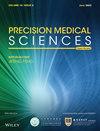Green approach for fabrication of chitosan‐neem gum polyelectrolyte stabilized penta and hexagonal nanoparticles and in‐vitro cytotoxic potential toward breast cancer (MCF‐7) cells
IF 0.6
Q4 MEDICINE, RESEARCH & EXPERIMENTAL
引用次数: 3
Abstract
The present investigation aimed to utilize chitosan‐neem gum polysaccharide (Ch‐NGP) polyelectrolyte complex for the fabrication of hexagonal and pentagonal nanoparticles using antisolvent precipitation method. Fabricated nanoparticles were found in the range of 63.1 to 447.2 nm with the entrapment efficiency of 76.80 ± 1.28 to 89.82 ± 2.32%. A nonlinear correlation between the independent variable and response was observed after the regression coefficient based linearity analysis. Drug release was carried out using the egg membrane and tomato membrane as a biological barrier. All the formulations show peculiar release pattern viz. initial immediate release, followed by sustained release and final burst release of the drug. Similarity factor analysis easily showed a significant difference in drug release patterns when the egg membrane and tomato membrane were utilized as biological barriers (S˂50). Anticancerous effect against breast cancer cells line (MCF‐7) shows better control over cell growth when etoricoxib loaded nanoparticles were used in place of pure etoricoxib. Particle size growth analysis elicits that significantly no “Ostwald ripening” was observed after 45 days. It can be concluded from the findings of the experiments that Ch‐NGP polyelectrolyte functionalized hexagonal and pentagonal nanoparticles can be utilized for passive targeting of tumor cells due to its unique properties.壳聚糖-楝树胶聚电解质稳定的五边形和六边形纳米颗粒的绿色制备方法及其对乳腺癌(MCF - 7)细胞的体外细胞毒性潜力
本研究旨在利用壳聚糖-印楝胶多糖(Ch - NGP)聚电解质配合物,采用反溶剂沉淀法制备六边形和五边形纳米粒子。纳米颗粒的粒径范围为63.1 ~ 447.2 nm,包封效率为76.80±1.28 ~ 89.82±2.32%。基于回归系数的线性分析发现自变量与响应呈非线性相关。利用鸡蛋膜和番茄膜作为生物屏障进行药物释放。所有制剂均表现出独特的释药模式,即先缓释,后缓释,最后突然释放。相似因子分析表明,以鸡蛋膜和番茄膜作为生物屏障时,药物释放模式有显著差异(S小于50)。在乳腺癌细胞系(MCF‐7)的抗癌作用中,使用装载依托托昔布的纳米颗粒代替纯依托托昔布,可以更好地控制细胞生长。粒径增长分析表明,45天后未观察到明显的“奥斯特瓦尔德成熟”。实验结果表明,Ch - NGP聚电解质功能化的六边形和五边形纳米颗粒由于其独特的性质,可以用于肿瘤细胞的被动靶向。
本文章由计算机程序翻译,如有差异,请以英文原文为准。
求助全文
约1分钟内获得全文
求助全文

 求助内容:
求助内容: 应助结果提醒方式:
应助结果提醒方式:


